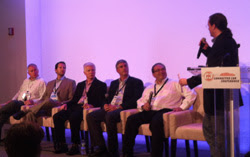 |
| Tina Jeffrey |
The recurring theme throughout the event was that HTML5 is mainstream. Even though HTML5 still requires some ripening as a technology, it is definitely the burgeoning choice for app developers who wish to get their apps onto as many platforms as possible, quickly and cost effectively. And when a developer is confronted with a situation where HTML5 falls short (perhaps a feature that isn’t yet available), then hybrid is always an option. At the end of the day, user experience is king, and developers need to design and ship apps that offer a great experience and keep users engaged, regardless of the technology used.
Mainstream mobile device platforms all have web browsers to support HTML5, CSS3, and JavaScript. And there’s definitely no shortage of mobile web development frameworks to build consumer and enterprise apps that look and perform like native programs. Many of these frameworks were discussed at the conference, including jQuery Mobile, Dojo Mobile, Sencha Touch, and Angular JS. Terry Ryan of Adobe walked through building a PhoneGap app and discussed how the PhoneGap Build tool lets programmers upload their code to a cloud compiler and automatically generate apps for every supported platform — very cool.
My colleague Rich Balsewich, senior enterprise developer at BlackBerry, hit a homerun with his presentation on the multiple paths to building apps. He walked us through developing an HTML5 app from end to end, and covered future features and platforms, including the automobile. A special shout-out to Rich for plugging my session “The Power of HTML5 in the Automobile” held later that afternoon.
My talk provided app developers with some insight into creating apps for the car, and discussed the success factors that will enable automakers to leverage mobile development — key to achieving a rich, personalized, connected user experience. Let me summarize with the salient points:
| What’s needed | What we're doing about it |
| The automotive community wants apps, and HTML5 provides a common app platform for infotainment systems. | We’ve implemented an HTML5 application framework in the QNX CAR Platform for Infotainment. |
| Automotive companies must leverage the broad mobile developer ecosystem to bring differentiated automotive apps and services to the car. | We’re helping by getting the word out and by building a cloud-based app repository that will enable qualified app partners to get their apps in front of automotive companies. We plan to roll out this repository with the release of the QNX CAR Platform 2.1 in the fall. |
| The developer community needs standardized automotive APIs. | We’re co-chairing the W3C Automotive and Web Platform Business Group, which has a mandate to create a draft specification of a vehicle data API. We’re also designing the QNX CAR Platform APIs to be Apache Cordova-compliant. |
| Automotive platform vendors must supply tools that enable app developers to build and test their apps. | We plan to release the QNX CAR Platform 2.1 with open, accessible tooling to make it easy for developers to test their apps in a software-only environment. |





























































